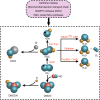Promising Antioxidative Effect of Berberine in Cardiovascular Diseases
- PMID: 35321323
- PMCID: PMC8936808
- DOI: 10.3389/fphar.2022.865353
Promising Antioxidative Effect of Berberine in Cardiovascular Diseases
Abstract
Berberine (BBR), an important quaternary benzylisoquinoline alkaloid, has been used in Chinese traditional medicine for over 3,000 years. BBR has been shown in both traditional and modern medicine to have a wide range of pharmacological actions, including hypoglycemic, hypolipidemic, anti-obesity, hepatoprotective, anti-inflammatory, and antioxidant activities. The unregulated reaction chain induced by oxidative stress as a crucial mechanism result in myocardial damage, which is involved in the pathogenesis and progression of many cardiovascular diseases (CVDs). Numerous researches have established that BBR protects myocardium and may be beneficial in the treatment of CVDs. Given that the pivotal role of oxidative stress in CVDs, the pharmacological effects of BBR in the treatment and/or management of CVDs have strongly attracted the attention of scholars. Therefore, this review sums up the prevention and treatment mechanisms of BBR in CVDs from in vitro, in vivo, and finally to the clinical field trials timely. We summarized the antioxidant stress of BBR in the management of coronary atherosclerosis and myocardial ischemia/reperfusion; it also analyzes the pathogenesis of oxidative stress in arrhythmia and heart failure and the therapeutic effects of BBR. In short, BBR is a hopeful drug candidate for the treatment of CVDs, which can intervene in the process of CVDs from multiple angles and different aspects. Therefore, if we want to apply it to the clinic on a large scale, more comprehensive, intensive, and detailed researches are needed to be carried out to clarify the molecular mechanism and targets of BBR.
Keywords: Berberine; cardiovascular disease; coronary atherosclerosis; myocardial infarction/reperfusion; reactive oxygen species.
Copyright © 2022 An, Zhang, Li, Yuan, Yang, Zhang, Gao and Xing.
Conflict of interest statement
The authors declare that the research was conducted in the absence of any commercial or financial relationships that could be construed as a potential conflict of interest.
Figures




Similar articles
-
Berberine protects rat heart from ischemia/reperfusion injury via activating JAK2/STAT3 signaling and attenuating endoplasmic reticulum stress.Acta Pharmacol Sin. 2016 Mar;37(3):354-67. doi: 10.1038/aps.2015.136. Epub 2016 Jan 25. Acta Pharmacol Sin. 2016. PMID: 26806299 Free PMC article.
-
Therapeutic effect of berberine on metabolic diseases: Both pharmacological data and clinical evidence.Biomed Pharmacother. 2021 Jan;133:110984. doi: 10.1016/j.biopha.2020.110984. Epub 2020 Nov 10. Biomed Pharmacother. 2021. PMID: 33186794 Review.
-
Berberine a traditional Chinese drug repurposing: Its actions in inflammation-associated ulcerative colitis and cancer therapy.Front Immunol. 2022 Dec 6;13:1083788. doi: 10.3389/fimmu.2022.1083788. eCollection 2022. Front Immunol. 2022. PMID: 36561763 Free PMC article. Review.
-
Protective effects of berberine on various kidney diseases: Emphasis on the promising effects and the underlined molecular mechanisms.Life Sci. 2022 Oct 1;306:120697. doi: 10.1016/j.lfs.2022.120697. Epub 2022 Jun 16. Life Sci. 2022. PMID: 35718235 Review.
-
Berberine Pretreatment Confers Cardioprotection Against Ischemia-Reperfusion Injury in a Rat Model of Type 2 Diabetes.J Cardiovasc Pharmacol Ther. 2016 Sep;21(5):486-94. doi: 10.1177/1074248415627873. Epub 2016 Feb 4. J Cardiovasc Pharmacol Ther. 2016. PMID: 26846272
Cited by
-
Berberine potentiates liver inflammation and fibrosis in the PI*Z hAAT transgenic murine model.PLoS One. 2024 Sep 19;19(9):e0310524. doi: 10.1371/journal.pone.0310524. eCollection 2024. PLoS One. 2024. PMID: 39298444 Free PMC article.
-
Network Pharmacology and In Vivo Experimental Verification of the Mechanism of the Qing'e Pill for Treating Intervertebral Disc Degeneration.Curr Comput Aided Drug Des. 2025;21(4):534-548. doi: 10.2174/0115734099356426241119051916. Curr Comput Aided Drug Des. 2025. PMID: 39623712 Free PMC article.
-
Inflammatory markers and noncoding-RNAs responses to low and high compressions of HIIT with or without berberine supplementation in middle-aged men with prediabetes.Physiol Rep. 2024 Aug;12(15):e16146. doi: 10.14814/phy2.16146. Physiol Rep. 2024. PMID: 39107107 Free PMC article. Clinical Trial.
-
Pharmacological properties and therapeutic potential of berberine: a comprehensive review.Front Pharmacol. 2025 Aug 14;16:1604071. doi: 10.3389/fphar.2025.1604071. eCollection 2025. Front Pharmacol. 2025. PMID: 40894216 Free PMC article. Review.
-
Effect of Alpha-Lipoic Acid on Rat Ventricles and Atria under LPS-Induced Oxidative Stress.Antioxidants (Basel). 2022 Apr 8;11(4):734. doi: 10.3390/antiox11040734. Antioxidants (Basel). 2022. PMID: 35453419 Free PMC article.
References
-
- Affuso F., Ruvolo A., Micillo F., Saccà L., Fazio S. (2010). Effects of a Nutraceutical Combination (Berberine, Red Yeast rice and Policosanols) on Lipid Levels and Endothelial Function Randomized, Double-Blind, Placebo-Controlled Study. Nutr. Metab. Cardiovasc. Dis. 20, 656–661. 10.1016/j.numecd.2009.05.017 - DOI - PubMed
Publication types
LinkOut - more resources
Full Text Sources

